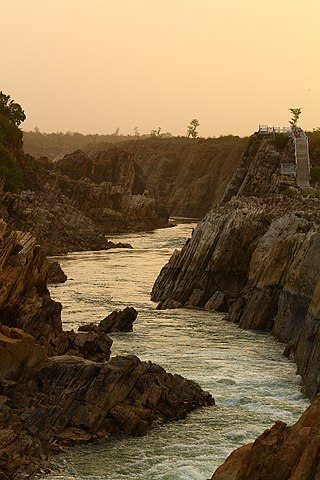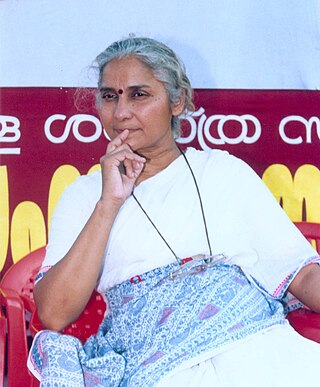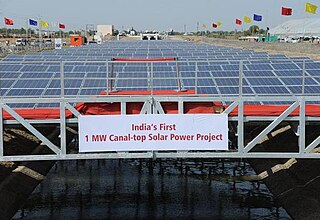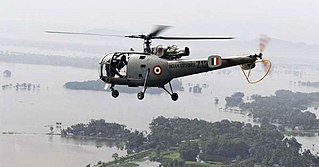
The Narmada River, also called the Reva and previously also known as Narbada or anglicised as Nerbudda, is the 5th longest river and overall longest west-flowing river in India. It is also the largest flowing river in the state of Madhya Pradesh. This river flows through the states of Madhya Pradesh and Gujarat in India. It is also known as the "Life Line of Madhya Pradesh and Gujarat" due to its huge contribution to the two states in many ways. The Narmada River rises from the Amarkantak Plateau in Anuppur district Madhya Pradesh. It forms the traditional boundary between North India and South India and flows westwards over a length of 1,312 km (815.2 mi) before draining through the Gulf of Khambhat into the Arabian Sea, 30 km (18.6 mi) west of Bharuch city of Gujarat.

The Sardar Sarovar Dam is a concrete gravity dam built on the Narmada River in Navagam near the town of Kevadiya, Narmada District, in the state of Gujarat, India. The dam was constructed to provide water and electricity to four Indian states: Gujarat, Madhya Pradesh, Maharashtra, and Rajasthan.

Saurashtra, also known as Kathiawar, is a peninsular region of Gujarat, India, located on the Arabian Sea coast. It covers about a third of Gujarat state, notably 11 districts of Gujarat, including Rajkot District. It was formerly a state of India before it merged with Bombay state. In 1961 it separated from Bombay and joined Gujarat.

Narmada Bachao Andolan (NBA) is an Indian social movement spearheaded by native tribals (adivasis), farmers, environmentalists and human rights activists against a number of large dam projects across the Narmada River, which flows through the states of Gujarat, Madhya Pradesh and Maharashtra. Sardar Sarovar Dam in Gujarat is one of the biggest dams on the river and was one of the first focal points of the movement. It is part of the Narmada Dam Project, whose main aim is to provide irrigation and electricity to people of the above states.

Medha Patkar is a politician and activist working on certain political and social issues raised by tribals, dalits, farmers, labourers and women facing injustice in India. She is an alumnus of TISS, a premier institute of social science research in India..
The Indira Sagar Dam is the largest dam in India, in terms of volume of water stored in the reservoir. It is located on the Narmada River at the town of Narmada Nagar, Punasa in the Khandwa district of Madhya Pradesh in India. The foundation stone of the project was laid by the prime minister of India Indira Gandhi on 23 October 1984. The construction of the main dam started in 1992. The downstream projects of ISP are Omkareshwar, Maheshwar, and Sardar Sarovar Project. To build it, a town of 22,000 people and 100 villages was displaced.

Sabarmati Riverfront is a waterfront being developed along the banks of Sabarmati river in Ahmedabad, India. Proposed in the 1960s, the construction began in 2005. Since 2012, the waterfront is gradually opened to public as and when facilities are constructed and various facilities are actively under construction. The major objectives of project are environment improvement, social infrastructure and sustainable development.

Aji River is one of the main rivers of saurashtra (region), Gujarat State. Aji I dam on this river is called the lifeline of Rajkot City and separates Rajkot in east-west parts. There are four dams on Aji River, the water from which is used for agriculture and as drinking water.

Interbasin transfer or transbasin diversion are terms used to describe man-made conveyance schemes which move water from one river basin where it is available, to another basin where water is less available or could be utilized better for human development. The purpose of such water resource engineering schemes can be to alleviate water shortages in the receiving basin, to generate electricity, or both. Rarely, as in the case of the Glory River which diverted water from the Tigris to Euphrates River in modern Iraq, interbasin transfers have been undertaken for political purposes. While ancient water supply examples exist, the first modern developments were undertaken in the 19th century in Australia, India and the United States, feeding large cities such as Denver and Los Angeles. Since the 20th century many more similar projects have followed in other countries, including Israel and China, and contributions to the Green Revolution in India and hydropower development in Canada.

The Kalpasar Project or the Gulf of Khambhat Development Project envisages building a 30 km dam across the Gulf of Khambat in India for establishing a huge fresh water coastal reservoir for irrigation, drinking and industrial purposes. The project with 30 km sea dam will have the capacity to store 10,000 million cubic meters fresh water, equating to 25% of Gujarat’s average annual rainwater flow, from the rivers like Narmada, Mahi, Dhadhar, Sabarmati, Limbdi-Bhagovo, and two other minor rivers. A 10 lane road link will also be set up over the dam, greatly reducing the distance between Saurashtra and South Gujarat. The project, which will create world's largest freshwater lake in marine environment, will cost INR90,000 crore or US$12.75 billion excluding the cost of tidal power plant. Project entails construction of the main "Kalpasar dam" across Gulf of Khambat and another Bhadbhut barrage on Narmada river, as well as a canal connecting the two.

Sadbhav Engineering Limited (SEL) is an Indian civil engineering and construction company headquartered in Ahmedabad. Founded in 1988 by Mr. Vishnubhai M. Patel, the company has implemented projects in the construction of roads & highways, bridges, mining and irrigation-supporting infrastructure. The company worked for clients including NHAI, DMRC, Sardar Sarovar Narmada Nigam, Coal India, L&T, HCC, Punj Lloyd and various others.

The Statue of Unity is the world's tallest statue, with a height of 182 metres, located near Kevadia in the state of Gujarat, India. It depicts Indian statesman and independence activist Vallabhbhai Patel (1875–1950), who was the first deputy prime minister and home minister of independent India and an adherent of Mahatma Gandhi. Patel is highly respected for his leadership in uniting 562 princely states of India to form the single Union of India. The statue is located in Gujarat on the Narmada River in the Kevadiya colony, facing the Sardar Sarovar Dam 100 kilometres (62 mi) southeast of the city of Vadodara.
Narmada Valley Development Authority (NVDA) concerns Narmada River, the river of Madhya Pradesh. With 87% of its catchment area lying in Madhya Pradesh, it becomes all the more important for the state to exploit this enormous water resource. It was with this motto in mind that the Narmada Valley Development Authority (NVDA) was formed by the government of MP on 9 August 1985. NVDA oversees all major development projects in the Narmada Basin. The body also ensures that proper rehabilitation is provided to the displaced, and the negative impacts on environment are minimized by taking appropriate measures.

The Narmada Canal is a contour canal in Western India that brings water from the Sardar Sarovar Dam to the state of Gujarat and then into Rajasthan state. The main canal has a length of 532 kilometres (331 mi). It is the second longest canal in India and the largest canal by water carrying capacity. The main canal is connected with 42 branch canals providing irrigation to 2,129,000 hectares farmland. The canal is designed to transfer 9.5 million acre-feet water annually from the Narmada Basin to areas under other river basins in Gujarat and Rajasthan..

The Canal Solar Power Project is a solar canal project launched in Gujarat, India, to use the 532 km (331 mi) long network of Narmada canals across the state for setting up solar panels to generate electricity. It was the first ever such project in India. This project has been commissioned by SunEdison India.

Following heavy rain in July 2017, the Indian state of Gujarat was affected by severe flooding. The floods were reported to have caused total 224 deaths between 1 June and 31 July 2017. 16 people had died in neighbouring Rajasthan state by 31 July.

Rajkot International Airport, also known as Hirasar Airport is an international airport and a greenfield airport at Hirasar, Gujarat, India, serving the city of Rajkot and the Saurashtra region. It is located near the National Highway 8B (NH-8B) connecting Ahmedabad and Rajkot. It has a single runway for the operation of ‘C’ category aircraft. The airport was developed by the Airports Authority of India (AAI) at a cost of ₹2,654 crore (US$330 million). The foundation stone for the construction of the airport was laid on 7 October 2017, and was inaugurated by Prime Minister Narendra Modi on 27 July 2023, which was previously expected to be done on 31 December 2023.
Bhagiratha is a safe drinking water project for every village in Telangana State, with a budget of ₹43,791 crores. The project is a brainchild of Telangana Chief Minister, K. Chandrashekar Rao, that aims to provide piped water to 2.32 crore people in 20 lakh households in urban and 60 lakhs in rural areas of Telangana. The ambitious project will supply clean drinking water to all households in the state through water sourced from River Godavari and River Krishna (32.43TMC). The bulk supply is expected to be completed by May 2018 and intra-village, intra-locality works will be completed by December 2018.
Satyanarayansinh Shivsinh Rathore is an Indian civil engineer. He belongs to the royal family of Valasna State. He is popularly known as the “highway and canal man of Gujarat”.
The Bhadbhut barrage or Bhadbhut dam is an under construction barrage on Narmada river near Bhadbhut village in Bharuch district, Gujarat, India. The construction started on 7 August 2020 and will be completed by 2025.















